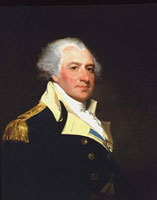Morocco seized the first U.S. ship in 1784
Morocco was the first country to seize a U.S. ship. The Betsey was a merchant brig and was seized off the coast of Spain in 1784.
Great Britain recognized the independence of the U.S. by the Treaty of Paris signed in September 1783. U.S. ships ceased to enjoy Royal Navy protection.
The newly independent colonies were not expected to last very long. The Continental Congress had 16 Presidents before George Washington was elected in 1789.
 Thomas Mifflin, Continental Congress President for only 7 months. Thomas Mifflin, Continental Congress President for only 7 months. |
When the first ship was seized, the new Republic was in a very precarious position.
Thomas Mifflin was Continental Congress President, and Sidi Muhammad III was Sultan of Morocco.
Great Britain recognized the independence of the U.S. in 1783, and the very next year the first ship was seized by Moroccan pirates.
 Sultan Sidi Muhammad (1710-1790). Sultan Sidi Muhammad (1710-1790). |
The news of the ship’s capture by Moroccan pirates reached the U.S. in 1785:
News of the Betsey’s capture reached the United States by February 1785. The American press received and expressed grossly exaggerated accounts both of the Betsey’s capture and of the general situation in the Mediterranean. Reports of multiple captures by Morocco and Algiers were detailed in several newspapers, while leading papers in Pennsylvania and Virginia reported that an American captain had discovered from an Englishman that as many as six American ships had been seized by the Moors and their crews sold into captivity. By the summer of 1785, the media exaggerations subsided as hard facts emerged. (London, Victory in Tripoli, pp. 27-28).
The release of the crew was obtained by Spain’s foreign minister who was vitally interested in gaining control of the former British colonies:
The situation was satisfactorily resolved with the friendly intervention of Spain’s foreign minister, conde de Floridablanca. Besides spreading goodwill, the minister was eager to resolve the Mississippi question in North America and hoped that his intercession would help to maintain cordial relations with the United States—a potentially valuable regional ally against the British. On July 9, 1785, the emperor of Morocco liberally agreed to release the Betsey, including her crew and her cargo, in exchange for America’s pledge to send a peace negotiator very soon to conclude a formal treaty. During the intervening months, the cargo and ship were lost, but Moroccan affability prevailed and restitution was made. (London, Victory in Tripoli, pp. 27-28).
The very same year, Algeria declared war on the United States—the first nation to do so:
A mere three months after the Betsey was seized, however, a far greater disaster befell the United States in Barbary. Two American ships and their combined crew of twenty-one men were captured and enslaved by Algerian pirates. The Boston schooner Maria (or Mary), commanded by Captain Isaac Stevens, was seized off Cape Saint Vincent, at the southern tip of Portugal, on July 24, and the Philadelphia ship Dauphin (or Dolphin), commanded by Captain Richard O’Brien, was seized off Cadiz, Spain, on July 30, 1785. But this time Spain was not coming to the rescue. (London, Victory in Tripoli, pp. 27-28).
__________________________________________________________________________________
Vital Link
You Tube video. Muslim Black Slavery Exposed
__________________________________________________________________________________
References
Brighton, Ray. The Checkered Career of Tobias Lear. Portsmouth Marine Society, Portsmouth, NH,1985.
Bartlee, W.B. The Assassins: The Story of Medieval Islam’s Secret Sect. Sutton Publishing, Gloustershire, UK, 2002.
De Kay, James Tertius. A Rage for Glory: The Life of Commodore Stephen Decatur, USN. Free Press, New York, 2004.
Fremont-Barnes, Gregory. The Wars of the Barbary Pirates Osprey Publishing, Oxford, UK, 2006.
London, Joshua E. Victory in Tripoli. John Wiley & Sons, Inc., Hoboken, NJ, 2005.
Roberts Priscilla H & Richard S. Thomas Barclay (1728-1793) Consul in France, Diplomat in Barbary. Bethlehem: Lehigh University Press, 2008.
Dawood, N.J. The Koran with Parallel Arabic Text Penguin Classics , New York & London, 1990.
Gabriel, Mark A. Islam and Terrorism. What the Quaran Really Teaches About Christianity, Violence and the Goals of the Islamic World Charisma House. Lake Mary, Florida, 2002.
Gordon, Murray. Slavery in the Arab World New Amsterdam Books, New York, 1998.
Khan. M.A. Islamic Jihad. A Legacy of Forced Conversion, Imperialism, and Slavery iUniverse, Inc., New York & Bloomington, 2009.
Posted by Reformation.org with permission
Filed under: "Enemy Within America", "engagement with the Muslim world", "lesser jihad", America, Anti-American, anti-Christian, Barack Hussein Obama, Creeping Sharia, cultural jihad, Islam, Islamic hate and intolerance, Islamic Indoctrination, Islamic Infiltration, Islamic intimidation, Islamic Jihad, Islamic Law, Islamic Threat | Tagged: Islam, Random, United States, war with Islam | Leave a comment »











